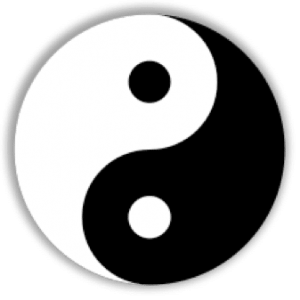Last updated: March 20, 2020

Yin is an adjective, although the term is sometimes used as a noun. That’s okay; there is no need to be dogmatic. Yin and yang are relative: nothing is absolutely one or the other. Consider the famous taijitu symbol shown here. Notice how even within the dark, yin swirl there is a white, yang dot, and vice versa. Notice also how there is an energetic movement between the swirls: yin becomes yang and yang become yin.
Yin describes things that are relatively darker, denser, cooler, hidden, more interior, more feminine, more mysterious. It literally refers to the shady side of a hill or river. Yang describes things that are relatively brighter, lighter, warmer, more superficial, more obvious. It refers to the sunny side of a hill or river. Yin also is relatively wetter while yang is dryer. These attributes can be applied to our yoga practices. In general, a very physical, hot, active practice would be considered yang relative to a calmer, cooler, more passive practice. For example, restorative yoga is yin-like relative to vinyasa yoga, which is yang-like.
The practice of Yin Yoga incorporates the yin elements of passive, non-striving, long-duration stresses targeting the yin-like tissues of the body—the fascia, which includes the ligaments, tendons, joint capsules and even the bones. There are 3 or 4 general principles followed in the practice of Yin Yoga as developed by Paul Grilley:
- When coming into a pose, come to your first stopping point and relax (don’t force past your edge). This is the place where there is some challenge, but not the maximum stress. (Maximum stress would make this a yang practice.)
- Once you have reached the appropriate edge, where you are feeling some reasonable amount of stress, relax. Become still. If your edge moves, however, and there is no more challenge, it is okay to move to find a new edge. But we are not looking for the greatest range of motion (yang); we are looking for reasonable sensations (yin).
- Stay in the posture for time. The amount of time will vary, but generally it is 1 to 10 minutes, depending on the person and the posture. When the sensations grow too intense (too yang), it is time to back off or come out of the pose (yin). Time is more important than intensity. It is better to linger longer at a lesser depth than to go deeper.
- When coming out of a pose, come out slowly, gingerly. The pose does create a sense of fragility; you have been literally pulling your body apart. Give yourself time to enjoy the rebound period between postures as the body returns to neutral.
The practice of yoga affects us on many levels: physically, emotionally, mentally and even spiritually. Yin Yoga is the same. On a physical level, the long-held postures create mechanical stresses within the fascial tissues. These stresses are important to regain and maintain the health of these tissues, but as in anything in life, you can do too much. If there is any pain arising from the practice or when you come out of the postures, you may have gone too deep or stayed too long. Modify the practice so these sensations do not arise. Seek balance: not too much, but not too little either. Go for the Goldilocks’ position where it is just right.
Physically, our intention in Yin Yoga is to create a reasonable amount of stress in the fascial tissues and let these stresses linger. Notice, the intention is not to go to end range of motion, although that may happen and if it is pain free, that is okay. On a psycho-emotional level, our intention can be to practice presence, to attend to the sensations arising, or to monitor the breath or to watch the flow of energy within.
What I have described is the style of Yin Yoga that I learned from Sarah Powers and Paul Grilley; however, there are other practices that also go by the name of Yin Yoga. The history behind some of these practices and their naming, and the differences between them and what I call Yin Yoga, can be found in these pages:
Who owns Yin Yoga?
Yin Yoga or Restorative Yoga
The history of yin postures in Hatha Yoga
Now that you know what I mean by the term Yin Yoga, you are ready to look at some concerns and my comments on them.
Return to Topics
